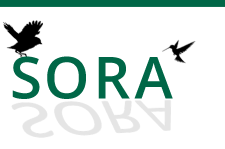Abstract
Un aperchamiento nocturno masivo de una especie migratoria, la Golondrina de Río Progne tapera, se reportó de mayo a octubre de cada año entre el 2010 y el 2017 en la Subestación Eléctrica El Vigía I de la empresa CORPOELEC, Municipio Alberto Adriani, Estado Mérida, Venezuela. En las visitas a la subestación se apreció el arribo diario de las golondrinas de río a aproximadamente las 18:30 h, posándose en cables y estructuras metálicas, culminando la actividad de apercharse a las 19:00 h. El despegue y alejamiento ocurría aproximadamente a las 06:00 h del día siguiente. La elección de este tipo de perchas pensamos que podría estar asociada a modificaciones en el funcionamiento de sus receptores electromagnéticos debido a las nuevas situaciones ambientales. Pero a comienzos de 2010 fue construida una estación generadora de electricidad al lado de la subestación, la cual producía un calor estable en las zonas laterales y explica en parte las razones para elegir a las estructuras metálicas de la subestación como perchas nocturnas. El número de individuos incrementó de mayo a septiembre cada año. Se estimó un tamaño relativo anual de estas poblaciones entre 50.000–100.000 individuos. El cambio de perchas naturales para usar estructuras antrópicas acarreó problemas biológico-ambientales con consecuencias económicas, sanitarias y de ingeniería. Frente a las iniciativas de control poblacional de la Golondrina de Río por parte de CORPOELEC, se recomendó tener responsabilidad conservacionista. Las acciones deberían mantener en buenas condiciones ingenieriles a la subestación, de conjunto con la aplicación de normas de protección para las aves, en concordancia con el resguardo de los recursos naturales del país. En 2018 la población disminuyó su tamaño con un cambio de lugar del aperchamiento, de manera concomitante con el cese de funcionamiento de la planta eléctrica lateral a la subestación eléctrica de El Vigía.
A massive nocturnal perching event of a migratory species, the Brown-chested Martin Progne tapera, was recorded from May to October every year between 2010–2017 at the Electrical Substation El Vigía I, Alberto Adriani County, Mérida state, Venezuela. During our visits to the substation, the daily arrival of the martins was observed at approximately 18:30 h, perching on cables and metal structures and finishing the activity of perching at 19:00 h. Takeoff and departure occurred the following day at approximately 06:00 h. We think that the choice of this type of perch could be associated with changes in the functionality of their electromagnetic receptors due to new environmental situations. But at the beginning of 2010, an electricity generating station was built next to the substation, which produced stable heat in the lateral zones and partly explains the reasons for choosing the metal structures of the substation as night perches. The number of individuals increased from May to September each year. An annual relative size of these populations was estimated to range between 50,000–100,000 individuals. The change of natural perches for the use of anthropic structures caused biological-environmental problems with economic, health, and engineering consequences. Given the initiatives of CORPOELEC to control the population of the River Swallow, it was recommended to have conservation responsibility. These actions should keep the substation in good condition with the application of protection standards for birds in accordance with the regulations for the protection of the country's natural resources. In 2018, the population studied changed the location of perching and decreased in size with the ending of the operation of the electricity generating station.
Creative Commons License
Recommended Citation
Angelino, Marisela and Péfaur, Jaime E.
(2022)
"Aperchamiento norcturno masivo de la golondrina de Río Progne tapera asociado a instalaciones eléctricas en Mérida, Venezuela / Massive Nocturnal Perching of the Brown-Chested Martin Progne tapera Associated with Electrical Structures in Mérida, Venezuela,"
Revista Venezolana de Ornitología: Vol. 12
:
Iss.
1
, Article 1.
Available at:
https://digitalcommons.usf.edu/rvo/vol12/iss1/1

